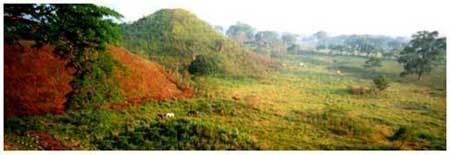Name Laguna de los Cerros Culture Olmec | Region Mesoamerica Chronology 1200 BCE to 900 CE | |
 | ||
Type Mesoamerican archaeology | ||
Bizarre 2300 year old olmec sculpture of huehjueteotl from laguna de los cerros
Laguna de los Cerros is a little-excavated Olmec and Classical era archaeological site, located in the vicinity of Corral Nuevo, within the municipality of Acayucan, in the Mexican state of Veracruz, in the southern foothills of the Tuxtla Mountains, some 30 kilometres (19 mi) south of the Laguna Catemaco.
Contents
- Bizarre 2300 year old olmec sculpture of huehjueteotl from laguna de los cerros
- Background
- History
- The site
- References
With Tres Zapotes, San Lorenzo Tenochtitlán, and La Venta, Laguna de los Cerros is considered one of the four major Olmec centers.
Laguna de los Cerros ("lake of the hills") was so named because of the nearly 100 mounds dotting the landscape. The basic architectural pattern consists of long parallel mounds flanking large rectangular plazas. Conical mounds mark the plaza ends. Larger mounds, formerly raised residential platforms, are associated with the thinner parallel mounds.
It has been confirmed that the site was not occupied during the postclassical period.
Most of the mounds date from the Classical era, roughly 250 CE through 900 CE.
This region, and the early Olmec people, presumably was the penetration point for commerce between the Mexico highlands and Tuxtepec routes.
Background
The first major culture in Veracruz was the Olmecs. The Olmecs settled in the Coatzacoalcos River region and it became the center of Olmec culture. The main ceremonial center here was San Lorenzo Tenochtitlán. Other major centers in the region include Tres Zapotes in the city of Veracruz and La Venta in Tabasco. The culture reached its height about 2,600 years ago, with its best-known artistic expression being the colossal stone heads. These ceremonial sites were the most complex of that early time period. For this reason, many anthropologists consider the Olmec civilization to be the mother civilization of the many Mesoamerican cultures that followed it. By 300 BCE, this culture was eclipsed by other emerging cultures in Mesoamerica.
History
Due to its location in a pass between the river valleys to the south and the northwest, and its proximity to basalt sources in the volcanic Tuxtla Mountains to the north, Laguna de los Cerros was occupied over an uncharacteristically long period – perhaps close to 2,000 years, from Olmec times until the Classic era.
Laguna de los Cerros was likely settled between 1400 - 1200 BCE and by 1200 BCE it had become a regional center, covering as much as 150 hectares (370 acres). By 1000 BCE, it had nearly doubled in size with 47 smaller sites within a 5 kilometres (3.1 mi) radius. One of these satellite sites was Llano del Jícaro, largely a workshop for monumental architecture due to the nearby basalt flows. Monuments carved from Llano del Jícaro basalt can be found not only at Laguna de los Cerros, but also the large Olmec center of San Lorenzo Tenochtitlán some 60 kilometres (37 mi) to the southeast. It is thought likely that Llano del Jícaro was controlled by San Lorenzo Tenochtitlán, either directly or through control of Laguna de los Cerros.
Llano del Jícaro was abandoned sometime after 1000 BCE and Laguna de los Cerros itself shows a significant decline at that time. The cause of this decline is not known – perhaps a shift in the course of the San Juan River – but it does roughly coincide with the decline and abandonment of San Lorenzo Tenochtitlán, which is often attributed to environmental difficulties.
Laguna de los Cerros was briefly investigated by Alfonso Medellin Zenil in 1960 and by Ann Cyphers in the late 1990s and early 2000s.
The site
Unlike the other three major Olmec sites, no colossal heads have been found at Laguna de los Cerros, although roughly two dozen other Formative period monuments have been found.
Important samples of ceramic, basalt stone and other materials were found in various excavations of the site during 1997 and 1998. The ceramic material classification was made on the macroscopic characteristics of the paste and surface. The comparative study of ceramics prior to the late classical period with pre-established sequences is ongoing.
The ceramic found correspond to various shapes, the main types are as follows :
Human burials were also found during excavations, some had ceramic and other offerings.
Also found many articles of different types and shapes, included are some 2,635 articles ranging from vessels, polishers, dishes, tablets, strikers, mortars, metates, basalt flakes, spheres, rings, sharpeners, etc.
The accuracy of the cultural development is based on the ceramic sequences used to generate it. The chronology, together with the prevailing poor state of preservation of the ceramics involved, affect the way in which such development may be understood. Chronologies in neighboring areas have been refined (for instance Pool 1990, 1995; Stark 1989, 1995, 2001; Daneels 2002), and they represent a major comparative support for the present study.
